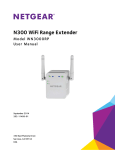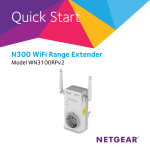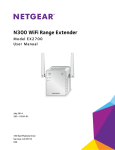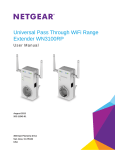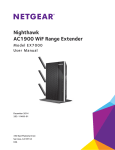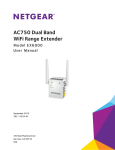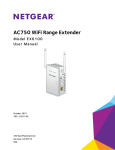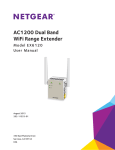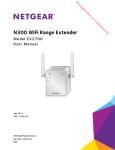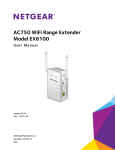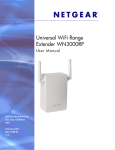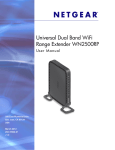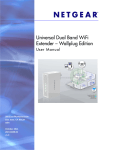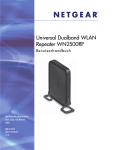Download Netgear WN3100RPv2 User Guide
Transcript
N300 WiFi Range Extender Model WN3100RPv2 User Manual February 2015 202-11455-01 350 East Plumeria Drive San Jose, CA 95134 USA N300 WiFi Range Extender Support Thank you for selecting NETGEAR products. After installing your device, locate the serial number on the label of your product and use it to register your product at https://my.netgear.com. You must register your product before you can use NETGEAR telephone support. NETGEAR recommends registering your product through the NETGEAR website. For product updates and web support, visit http://support.netgear.com. Phone (US & Canada only): 1-888-NETGEAR. Phone (Other Countries): Check the list of phone numbers at http://support.netgear.com/general/contact/default.aspx. Compliance For regulatory compliance information, visit http://www.netgear.com/about/regulatory. See the regulatory compliance document before connecting the power supply. Trademarks © NETGEAR, Inc. NETGEAR and the NETGEAR Logo are trademarks of NETGEAR, Inc. Any non-NETGEAR trademarks are used for reference purposes only. 2 Contents Chapter 1 Overview Meet Your Extender . . . . . . . . . . . . . . . . . . . . . . . . . . . . . . . . . . . . . . . . . . . . . . . . . . 6 When to Use Your Extender. . . . . . . . . . . . . . . . . . . . . . . . . . . . . . . . . . . . . . . . . . . . 7 How the Extender Works . . . . . . . . . . . . . . . . . . . . . . . . . . . . . . . . . . . . . . . . . . . . . . 7 Chapter 2 Get Started Use the Extender in Extender Mode. . . . . . . . . . . . . . . . . . . . . . . . . . . . . . . . . . . . Place the Extender and Apply Power . . . . . . . . . . . . . . . . . . . . . . . . . . . . . . . . . Connect to an Existing WiFi Network . . . . . . . . . . . . . . . . . . . . . . . . . . . . . . . . Find the Best Location . . . . . . . . . . . . . . . . . . . . . . . . . . . . . . . . . . . . . . . . . . . . . Connect an Ethernet-Enabled Device . . . . . . . . . . . . . . . . . . . . . . . . . . . . . . . . Use the Extender in Access Point Mode. . . . . . . . . . . . . . . . . . . . . . . . . . . . . . . . . Log In to the Extender After Installation . . . . . . . . . . . . . . . . . . . . . . . . . . . . . . . . Run Smart Setup Installation . . . . . . . . . . . . . . . . . . . . . . . . . . . . . . . . . . . . . . . . . . Chapter 3 Extender Network Settings Adjust the WiFi Coverage . . . . . . . . . . . . . . . . . . . . . . . . . . . . . . . . . . . . . . . . . . . . . View Connected Devices . . . . . . . . . . . . . . . . . . . . . . . . . . . . . . . . . . . . . . . . . . . . . View WiFi Settings. . . . . . . . . . . . . . . . . . . . . . . . . . . . . . . . . . . . . . . . . . . . . . . . . . . Change the WiFi Network Name . . . . . . . . . . . . . . . . . . . . . . . . . . . . . . . . . . . . . . . Turn Off the SSID Broadcast to Create a Hidden Network . . . . . . . . . . . . . . . . . Disable or Enable the WiFi Radio . . . . . . . . . . . . . . . . . . . . . . . . . . . . . . . . . . . . . . . Change the WiFi Speed. . . . . . . . . . . . . . . . . . . . . . . . . . . . . . . . . . . . . . . . . . . . . . . Use WPS to Add a Computer to the Extender’s WiFi Network. . . . . . . . . . . . . . Use WPS with the Push Button Method . . . . . . . . . . . . . . . . . . . . . . . . . . . . . . Use WPS with the PIN Method . . . . . . . . . . . . . . . . . . . . . . . . . . . . . . . . . . . . . . Specify WPS Settings . . . . . . . . . . . . . . . . . . . . . . . . . . . . . . . . . . . . . . . . . . . . . . . . Deny Access to a Computer or WiFi Device . . . . . . . . . . . . . . . . . . . . . . . . . . . . . Set Up an Access Schedule. . . . . . . . . . . . . . . . . . . . . . . . . . . . . . . . . . . . . . . . . . . . Set Up the Extender to Use a Static IP Address . . . . . . . . . . . . . . . . . . . . . . . . . . Chapter 4 10 10 10 13 14 14 16 17 19 19 20 21 21 22 23 24 25 25 26 27 29 30 Maintain and Monitor the Extender Change the Extender User Name and Password. . . . . . . . . . . . . . . . . . . . . . . . . . Turn Password Protection Off and On . . . . . . . . . . . . . . . . . . . . . . . . . . . . . . . . . . Recover a Forgotten User Name or Password. . . . . . . . . . . . . . . . . . . . . . . . . . . . Automatically Adjust for Daylight Saving Time. . . . . . . . . . . . . . . . . . . . . . . . . . . Manually Set the Extender Clock . . . . . . . . . . . . . . . . . . . . . . . . . . . . . . . . . . . . . . Back Up and Manage the Extender Configuration . . . . . . . . . . . . . . . . . . . . . . . . 3 32 33 33 34 34 35 N300 WiFi Range Extender Back Up the Configuration Settings. . . . . . . . . . . . . . . . . . . . . . . . . . . . . . . . . . Restore the Configuration Settings . . . . . . . . . . . . . . . . . . . . . . . . . . . . . . . . . . Return the Extender to Its Factory Default Settings . . . . . . . . . . . . . . . . . . . . . . Use the Factory Reset Button . . . . . . . . . . . . . . . . . . . . . . . . . . . . . . . . . . . . . . . Log In and Reset the Extender to Factory Settings . . . . . . . . . . . . . . . . . . . . . Update the Firmware . . . . . . . . . . . . . . . . . . . . . . . . . . . . . . . . . . . . . . . . . . . . . . . . Restart the Extender Remotely . . . . . . . . . . . . . . . . . . . . . . . . . . . . . . . . . . . . . . . . 35 35 37 37 38 39 40 Chapter 5 FAQs and Troubleshooting FAQs . . . . . . . . . . . . . . . . . . . . . . . . . . . . . . . . . . . . . . . . . . . . . . . . . . . . . . . . . . . . . . Extend a Network with MAC Filtering or Access Control Lists. . . . . . . . . . . . . . Cannot Connect to the Extender . . . . . . . . . . . . . . . . . . . . . . . . . . . . . . . . . . . . . . Cannot Join a WiFi Network and Receive an Error Message . . . . . . . . . . . . . . . . 42 43 46 46 Appendix A Factory Settings and Technical Specifications Factory Default Settings . . . . . . . . . . . . . . . . . . . . . . . . . . . . . . . . . . . . . . . . . . . . . 48 Technical and Environmental Specifications . . . . . . . . . . . . . . . . . . . . . . . . . . . . . 48 4 1. 1 Overview The WiFi Range Extender boosts your existing network range and speed, delivering dual-band WiFi. You can also use the extender in access point mode as a WiFi access point and create a new WiFi hotspot by using a wired Ethernet connection. This chapter covers the following topics: • Meet Your Extender • When to Use Your Extender • How the Extender Works Note: For more information about the topics covered in this manual, visit the support website at support.netgear.com. Note: Firmware updates with new features and bug fixes are made available from time to time on downloadcenter.netgear.com. Some products can regularly check the site and download new firmware, or you can check for and download new firmware manually. 5 N300 WiFi Range Extender Meet Your Extender Before you install your extender, familiarize yourself with its LEDs, buttons, and port. Router Arrow LED Client Arrow LED Router Link LED Client Link LED WPS button Ethernet port Power LED WPS LED Factory Reset button Device On/Off switch Power connector (varies by region) Pass-through power socket (varies by region) Figure 1. LEDs and USB port The following table describes the LEDs. Table 1. Front panel LEDs LED Router Link Client Link Description This LED indicates the connection between the extender and the router or access point. • Solid green. Best connection. • Solid amber. Good connection. • Solid red. Poor connection. • Off. No connection. This LED indicates the connection between the extender and a computer or WiFi device. • Solid green. Best connection. • Solid amber. Good connection. • Solid red. Poor connection. • Off. No connection. Overview 6 N300 WiFi Range Extender Table 1. Front panel LEDs (continued) LED Description Power • • • Solid amber. The extender is booting. Solid green. The extender is powered on. Off. The extender is powered off. WPS • • • Solid green. WiFi security is enabled (WPA or WPA2). Blinking green. A WPS connection is being established. Off. WiFi security is not enabled. Note: If the Router Arrow LED or Client Arrow LED blinks, see Find the Best Location on page 13. If no arrow LEDs light, the extender is in a good location. When to Use Your Extender NETGEAR recommends that you connect through the extender network only when the WiFi device is in a “dead zone” where connection from the existing network is poor or nonexistent. Data traffic routed through the extender is inherently slower than traffic routed directly from the network. How the Extender Works The extender works like a bridge between a WiFi router (or a WiFi access point) and a WiFi device outside the range of the WiFi router. The extender performs two main jobs: • The extender connects to a working WiFi network. When the extender connects over WiFi to an existing network, it functions as a network client, similar to how a WiFi device connects to a network. • The extender acts as an access point for WiFi devices. The extender broadcasts its own WiFi network that WiFi devices can join. In its role as an access point, the extender performs tasks that WiFi routers do, such as broadcasting its network name (SSID). The extender must do each of these jobs so that both ends of the bridge are in place. Overview 7 N300 WiFi Range Extender WiFi Range Extender Boosts the range of your existing WiFi and creates a stronger signal in hard-to-reach areas. Existing WiFi Sometimes your router does not provide the WiFi coverage that you need. Figure 2. Range extender in a home Overview 8 2. 2 Get Started This chapter covers the following topics: • Use the Extender in Extender Mode • Use the Extender in Access Point Mode • Log In to the Extender After Installation • Run Smart Setup Installation 9 N300 WiFi Range Extender Use the Extender in Extender Mode Place the extender, apply power, and connect it to your WiFi network. Note: You can also use the extender as a WiFi access point and create a new WiFi hotspot by using a wired Ethernet connection. See Use the Extender in Access Point Mode on page 14. Place the Extender and Apply Power To place the extender and apply power: 1. Place your extender in the same room as your WiFi router. Proximity to the WiFi router is required only during the initial setup process. 2. Plug the extender into an electrical outlet. 3. Wait for the Power LED to light amber and then turn green. If the Power LED does not light, slide the Device On/Off switch on the side of the extender to the On position. Connect to an Existing WiFi Network To extend the range of your WiFi network, you must connect the extender to your existing WiFi network. You can do this in one of two ways: • Connect with WPS. For more information, see Connect with WPS. • Connect with web browser setup. For more information, see Connect with Web Browser Setup on page 11. Connect with WPS Wi-Fi Protected Setup (WPS) lets you join a secure WiFi network without typing the network name and password. Note: WPS does not support WEP network security. If you are using WEP security, follow the instructions in Connect with Web Browser Setup on page 11. To use WPS to connect the extender to your WiFi router: 1. Press the WPS button your router or access point. 2. Within two minutes, press the WPS button on your extender. Get Started 10 N300 WiFi Range Extender The WPS LED lights solid green, the Router Link LED connects to your existing WiFi network. lights, and the extender If the Router Link LED does not light, try again. If it still does not light, see Connect with Web Browser Setup on page 11. 3. Find the new extender network name on your computer or WiFi device. The extender’s wireless network name (SSID) changes to your existing WiFi network name, with _EXT at the end of the name, for example: • Existing WiFi network name. MyNetworkName • New extended network name. MyNetworkName_EXT 4. Connect your computer or WiFi devices to the new extended WiFi network. Use the same WiFi password that you use for your WiFi router. 5. Unplug the extender and move it to a new location closer to the area with a poor WiFi signal. The location that you choose must be within the range of your existing WiFi router network. 6. Plug the extender into an electrical outlet. 7. Wait for the Power LED to light amber and then turn green. If the Power LED does not light, slide the Device On/Off switch on the side of the extender to the On position. 8. Use the Router Link LED on the front panel to help you choose a spot where the extender-to-router connection is optimal. Connect with Web Browser Setup You can use a web browser to log in to the extender and set up its WiFi connection to your existing WiFi router. To use a web browser to connect the extender to your WiFi router: 1. Use a WiFi network manager on a computer or WiFi device to find and connect to the NETGEAR_EXT WiFi network (SSID). After the connection with the computer or WiFi device is established, the Client Link LED lights solid green. 2. Open a web browser window from the same computer or WiFi device. The browser takes you directly to the extender login screen. If you are not automatically directed to login screen, enter www.mywifiext.net in the address field. The login screen displays. 3. Click the NEW EXTENDER SETUP button. Get Started 11 N300 WiFi Range Extender The first time that you log in to the extender, the Create Account screen displays. If the Create Account screen does not display, go to www.mywifiext.net. 4. Complete the fields and click the NEXT button. 5. When prompted, select your country or region from the Regional Settings menu and click the NEXT button. 6. Click the WIFI RANGE EXTENDER button. The extender scans for WiFi signals and finds the WiFi networks in your area and displays a list. 7. Select a WiFi network to extend and click the NEXT button. If your existing WiFi network is hidden, select the Manually input my wireless SSID radio button and type your WiFi network name. You are prompted to enter the password for the WiFi network that you selected. 8. Type the WiFi network password (also called passphrase or security key) in the Password (Network Key) field and click the NEXT button. 9. Set the network name (SSID) and password for your new extender WiFi network and click the NEXT button. The extender connects to your existing WiFi network. You are prompted to connect your computers and WiFi devices to the extender network. 10. Use a WiFi network manager on the computer or WiFi device to connect to the new extended WiFi network. Get Started 12 N300 WiFi Range Extender Repeat this step for all of your computers and WiFi devices. 11. Click the CONTINUE button. A message displays confirming that the extender is connected to the new extended WiFi network. 12. Click the NEXT button. The registration screen displays. 13. Complete the registration fields and click the FINISH button to complete the setup. If you do not want to register your extender, click the Skip Registration link. Note that you must register your extender before you can use NETGEAR telephone support. The Status screen displays. 14. Unplug the extender and move it to a new location closer to the area with a poor WiFi signal. The location that you choose must be within the range of your existing WiFi router network. 15. Plug the extender into an electrical outlet. Wait for the Power LED to light amber and then turn green. If the Power LED does not light, slide the Device On/Off switch to the On position. 16. Use the Router Link LED to help you choose a spot where the extender-to-router connection is optimal. The extender connects to your existing router’s WiFi network. Find the Best Location If the WiFi signal is weak, the first time you join the extender network, an arrow LED blinks for two minutes. If this happens, adjust the position of the extender. • If the Router Arrow LED • If the Client Arrow LED extender. blinks, move the extender closer to the router. blinks, move the computer or WiFi device closer to the If no arrow LEDs are lit, the extender is in a good location. Get Started 13 N300 WiFi Range Extender Connect an Ethernet-Enabled Device After the extender is connected to your existing WiFi network, you can connect a wired device to the extender using an Ethernet cable. The device can then access your existing network through the extender’s WiFi connection. Figure 3. Rear panel Ethernet LAN port Use the Extender in Access Point Mode You use the extender as a WiFi access point, which creates a new WiFi hotpsot by using a wired Ethernet connection. Figure 4. Extender in access point mode Get Started 14 N300 WiFi Range Extender To use the extender in access point mode: 1. Plug the extender into an electrical outlet. 2. Wait for the Power LED to light amber and then turn green. If the Power LED does not light, slide the Device On/Off switch on the side of the extender to the On position. 3. Use an Ethernet cable to connect the extender to the router Ethernet LAN port or the remote Ethernet LAN jack with LAN access. The extender joins the LAN and creates a WiFi hotspot. 4. Use a WiFi network manager on a computer or WiFi device to find and connect to the NETGEAR_EXT (SSID) WiFi network. After the connection with the computer or WiFi device is established, the Client Link LED lights. 5. Launch a web browser and enter www.mywifiext.net in the address field. A login screen displays. 6. Click the NEW EXTENDER SETUP button. The first time that you log in to the extender, the Create Account screen displays. If the Create Account screen does not display, visit www.mywifiext.net. 7. Complete the fields and click the NEXT button. You are prompted to select your region. 8. Select your country or region from the Regional Settings menu and click the NEXT button. Get Started 15 N300 WiFi Range Extender 9. Click the ACCESS POINT button. The extender checks for an Internet connection through the router that you connected to the extender. 10. Set the network name (SSID), security option, and password, and click the NEXT button. Your settings are applied and the extender is ready to be used as an access point. 11. Use a WiFi network manager on the computer or WiFi device to connect to the new access point network. 12. Repeat this step for all of your computers and WiFi devices. 13. Click the CONTINUE button. A screen displays that says you successfully created an access point. 14. Click the NEXT button. The registration screen displays. 15. Complete the registration fields and click the FINISH button to complete the setup. If you do not want to register your extender, click the Skip Registration link. Note that you must register your extender before you can use NETGEAR telephone support. The Status screen displays. Log In to the Extender After Installation You can log in to the extender to view or change the extender’s settings. To log in to the extender: 1. Use a WiFi network manager on a computer or WiFi device to find and connect to the new extended WiFi network. After the connection with the computer or WiFi device is established, the Client Link LED lights solid green. 2. Launch a web browser. 3. Enter www.mywifiext.net in the address field of the browser. A login screen displays. 4. Enter your email address and password and click the LOG IN button. The Status screen displays. Get Started 16 N300 WiFi Range Extender Run Smart Setup Installation You can use Smart Setup to change the extender settings. This is an easy way to connect the extender to a different router or to change the extender WiFi network name (SSID) or WiFi password. To run Smart Setup: 1. Use a WiFi network manager on a computer or WiFi device to find and connect to the new extended WiFi network. After the connection with the computer or WiFi device is established, the Client Link LED lights solid green. 2. Launch a web browser. 3. Enter www.mywifiext.net in the address field of the browser. A login screen displays. 4. Enter your email address and password and click the LOG IN button. The Status screen displays. 5. Click the SMART SETUP button. The Welcome screen displays. 6. Click the WIFI RANGE EXTENDER button. The extender scans for WiFi signals and finds the WiFi networks in your area and displays a list. 7. Select your WiFi network and click the NEXT button. 8. When prompted, enter the password to connect to your WiFi network and click the NEXT button. A message displays when the extender connects to your existing router’s WiFi network. 9. Click the NEXT button. The extender applies your settings to its WiFi network names and WiFi passwords. During this change, the extender disconnects you from its WiFi network. 10. When prompted, connect your WiFi devices to the extender WiFi network and click the CONTINUE button. The registration screen displays. 11. Complete the registration fields and click the FINISH button to complete the setup. If you do not want to register your extender, click the Skip Registration link. Note that you must register your extender before you can use NETGEAR telephone support. The Status screen displays. Get Started 17 3. Extender Network Settings This chapter covers the following topics: • Adjust the WiFi Coverage • View Connected Devices • View WiFi Settings • Change the WiFi Network Name • Turn Off the SSID Broadcast to Create a Hidden Network • Disable or Enable the WiFi Radio • Change the WiFi Speed • Use WPS to Add a Computer to the Extender’s WiFi Network • Specify WPS Settings • Deny Access to a Computer or WiFi Device • Set Up an Access Schedule • Set Up the Extender to Use a Static IP Address 18 3 N300 WiFi Range Extender Adjust the WiFi Coverage You can set the extender’s WiFi coverage depending on how large you want your coverage area to be. To adjust the WiFi coverage: 1. On a computer or WiFi device that is connected to the extender network, launch a web browser. 2. In the address field of your browser, enter www.mywifiext.net. You are prompted to enter a user name and password. 3. Enter your email address and password. 4. Click the Menu icon . The extender menu displays. 5. Select Do More > WiFi Coverage. 6. Select a Wireless Output Power radio button. If your extender is covering a small area, select a lower-output power percentage. If your extender is covering a large area, select a higher-output power percentage. 7. Click the SAVE button. Your settings are saved. View Connected Devices You can view a list of devices that are connected to the extender network. To view connected devices: 1. On a computer or WiFi device that is connected to the extender network, launch a web browser. 2. In the address field of your browser, enter www.mywifiext.net. You are prompted to enter a user name and password. 3. Enter your email address and password. Extender Network Settings 19 N300 WiFi Range Extender 4. Click the Menu icon . The extender menu displays. 5. Select Settings > Wireless > Connected Devices. View WiFi Settings To view the WiFi settings: 1. On a computer or WiFi device that is connected to the extender network, launch a web browser. 2. In the address field of your browser, enter www.mywifiext.net. You are prompted to enter a user name and password. 3. Enter your email address and password. 4. Click the Menu icon . The extender menu displays. 5. Select Settings > Wireless. The WiFi settings display. Extender Network Settings 20 N300 WiFi Range Extender Change the WiFi Network Name To change the WiFi network name: 1. On a computer or WiFi device that is connected to the extender network, launch a web browser. 2. In the address field of your browser, enter www.mywifiext.net. You are prompted to enter a user name and password. 3. Enter your email address and password. 4. Click the Menu icon . The extender menu displays. 5. Select Settings > Wireless. 6. In the Network Name (SSID) field, type a network name. 7. Click the SAVE button. Your settings are saved. Turn Off the SSID Broadcast to Create a Hidden Network By default, the extender broadcasts its WiFi signal so that its wireless network names (SSIDs) are easy for you to find and connect to from your computer, tablet, or smartphone. You can turn off the SSID broadcast to create a hidden WiFi network. To connect to a hidden network you must know its SSID and password and manually enter them. Extender Network Settings 21 N300 WiFi Range Extender To turn off the SSID broadcast to create a hidden network: 1. On a computer or WiFi device that is connected to the extender network, launch a web browser. 2. In the address field of your browser, enter www.mywifiext.net. You are prompted to enter a user name and password. 3. Enter your email address and password. 4. Click the Menu icon . The extender menu displays. 5. Select Settings > Wireless. 6. Clear the Broadcast Network Name (SSID) check box. 7. Click the SAVE button. Your settings are saved. Disable or Enable the WiFi Radio By default, the extender’s WiFi radio broadcasts a signal in the 2.4 GHz band. If you disable the WiFi radio, then no one can connect with WiFi to the extender. To disable or enable the WiFi radio: 1. On a computer or WiFi device that is connected to the extender network, launch a web browser. 2. In the address field of your browser, enter www.mywifiext.net. Extender Network Settings 22 N300 WiFi Range Extender You are prompted to enter a user name and password. 3. Enter your email address and password. 4. Click the Menu icon . The extender menu displays. 5. Select Settings > Wireless. 6. Select or clear the Enable 2.4 GHz WiFi check box. 7. Click the SAVE button. Your settings are saved. Change the WiFi Speed To change the WiFi speed: 1. On a computer or WiFi device that is connected to the extender network, launch a web browser. 2. In the address field of your browser, enter www.mywifiext.net. You are prompted to enter a user name and password. 3. Enter your email address and password. 4. Click the Menu icon . The extender menu displays. Extender Network Settings 23 N300 WiFi Range Extender 5. Select Settings > Wireless. 6. In the WiFi Speed menu, select a speed. 7. Click the SAVE button. Your settings are saved. Use WPS to Add a Computer to the Extender’s WiFi Network WPS (WiFi Protected Setup) lets you connect a computer or WiFi device to the extender’s network without entering the WiFi network passphrase or key. Instead, you use a WPS button or enter a PIN to connect. If you use the push button method, the WiFi device that you are trying to connect must include a physical push button or a software button. If you use the PIN method, you must know the PIN of the WiFi device that you are trying to connect. WPS supports WPA and WPA2 WiFi security. If your extender network is open (no WiFi security is set), connecting with WPS automatically sets WPA + WPA2 WiFi security on the extender network and generates a random passphrase. You can view this passphrase on the WiFi Settings screen (for more information, see View WiFi Settings on page 20). For information about using WPS to connect the extender to a WiFi network during setup, see Use the Extender in Access Point Mode on page 14. Extender Network Settings 24 N300 WiFi Range Extender Use WPS with the Push Button Method To use the push button method to connect a WiFi device to the extender’s WiFi network, the WiFi device that you are trying to connect must have a physical button or a software button. To use WPS to add a computer or WiFi device to the extender’s WiFi network: 1. On a computer or WiFi device that is connected to the extender network, launch a web browser. 2. In the address field of your browser, enter www.mywifiext.net. You are prompted to enter a user name and password. 3. Enter your email address and password. 4. Click the Menu icon . The extender menu displays. 5. Select Settings > Do More > Connect Devices (WPS). 6. Leave the Push Button (recommended) radio button selected. 7. Click the WIFI PROTECTED SETUP (WPS) button. The WPS LED blinks green for two minutes. For two minutes, the extender attempts to add the computer or WiFi device to its WiFi network. 8. Within two minutes, go to the computer WiFi device and press or click its WPS button. 9. To verify that the WiFi device is connected to the extender’s WiFi network, select Settings > Connected Devices. The WiFi device displays onscreen. Use WPS with the PIN Method To use the PIN method to connect a WiFi device to the extender’s WiFi network, you must know the PIN of the WiFi device that you are trying to connect. Extender Network Settings 25 N300 WiFi Range Extender To add a computer or WiFi device to the extender’s WiFi network: 1. On a computer or WiFi device that is connected to the extender network, launch a web browser. 2. In the address field of your browser, enter www.mywifiext.net. You are prompted to enter a user name and password. 3. Enter your email address and password. 4. Click the Menu icon . The extender menu displays. 5. Select Settings > Do More > Connect Devices (WPS). The Connect Devices (WPS) screen displays. 6. Select the PIN Number radio button. 7. Type the PIN of the WiFi device in the field. 8. Click the NEXT button. For four minutes, the extender attempts to find the computer or WiFi device. 9. Within four minutes, go to the WiFi device and use its WPS software to join the WiFi network. 10. To verify that the WiFi device is connected to the extender’s WiFi network, select Settings > Connected Devices. The WiFi device displays onscreen. Specify WPS Settings You can specify the following WPS settings: • Disable or enable the WPS PIN. • Enter the number of failed WPS PIN connection attempts that are allowed before the WPS PIN is automatically disabled. • Specify whether the WiFi settings stay the same when a new computer or device connects with WPS. Extender Network Settings 26 N300 WiFi Range Extender To specify WPS settings: 1. On a computer or WiFi device that is connected to the extender network, launch a web browser. 2. In the address field of your browser, enter www.mywifiext.net. You are prompted to enter a user name and password. 3. Enter your email address and password. 4. Click the Menu icon . The extender menu displays. 5. Select Settings > Wireless. The Wireless screen displays. 6. Scroll down to the Connect Devices (WPS) section: 7. Adjust the settings. 8. Click the SAVE button. Your settings are saved. Deny Access to a Computer or WiFi Device By default, access control is disabled so that it is easy for you to connect to the extender’s WiFi networks. You can deny network access to specific computers and WiFi devices based on their MAC addresses. Each network device is assigned a MAC address, which is a unique 12-character physical address containing the hexadecimal characters 0–9, a–f, or A–F only and separated by colons (for example, 00:09:AB:CD:EF:01). Typically, the MAC address is on the label of the WiFi device. If you cannot access the label, you can display the MAC address using the network configuration utilities of the computer. You might also find the MAC addresses on the Connected Devices screen (see View Connected Devices on page 19). Extender Network Settings 27 N300 WiFi Range Extender To use WiFi access control to deny access: 1. On a computer or WiFi device that is connected to the extender network, launch a web browser. 2. In the address field of your browser, enter www.mywifiext.net. You are prompted to enter a user name and password. 3. Enter your email address and password. 4. Click the Menu icon . The extender menu displays. 5. Select Settings > Wireless > Connected Devices. 6. In the WiFi Devices section, select the Enable Access Control check box. The WiFi devices table displays the names and MAC addresses of WiFi devices that are connected to the extender. 7. Select the Deny check box for the device. 8. Click the SAVE button. Your settings are saved and that device cannot connect to the extender’s WiFi network. Extender Network Settings 28 N300 WiFi Range Extender Set Up an Access Schedule You can control access to all users during specific periods of the day. You can set up an access schedule that prevents Internet access through the extender network based on the times that you set. To set up an access schedule: 1. On a computer or WiFi device that is connected to the extender network, launch a web browser. 2. In the address field of your browser, enter www.mywifiext.net. You are prompted to enter a user name and password. 3. Enter your email address and password. 4. Click the Menu icon . The extender menu displays. 5. Select Do More > Access Schedule. The Access Schedule screen displays. 6. Select the Access Schedule On radio button. 7. In the Days menu and the Time menu, select the days and time when you want to disable Internet access. 8. Click the Add Time button to add the time that you specified to the Scheduled Times table. 9. Click the SAVE button. Your settings are saved. Extender Network Settings 29 N300 WiFi Range Extender Set Up the Extender to Use a Static IP Address The extender comes set up to use a dynamic IP address, which is the correct setting for most home networks. To set up the extender to use a static IP address: 1. On a computer or WiFi device that is connected to the extender network, launch a web browser. 2. In the address field of your browser, enter www.mywifiext.net. You are prompted to enter a user name and password. 3. Enter your email address and password. 4. Click the Menu icon . The extender menu displays. 5. Select Settings > Wireless Settings. The WiFi Settings screen displays. 6. Scroll to the IP Address section. By default, the Dynamically get IP Address from Router radio button is selected. 7. Select the Use Static IP Address radio button. 8. Complete the fields to specify the IP network IP addresses. 9. Click the SAVE button. Your settings are saved. Extender Network Settings 30 4. Maintain and Monitor the Extender This chapter covers the following topics: • Change the Extender User Name and Password • Turn Password Protection Off and On • Recover a Forgotten User Name or Password • Automatically Adjust for Daylight Saving Time • Manually Set the Extender Clock • Back Up and Manage the Extender Configuration • Return the Extender to Its Factory Default Settings • Update the Firmware • Restart the Extender Remotely 31 4 N300 WiFi Range Extender Change the Extender User Name and Password You can change the user name and password to log in to the extender. To add an extender user: 1. On a computer or WiFi device that is connected to the extender network, launch a web browser. 2. In the address field of your browser, enter www.mywifiext.net. You are prompted to enter a user name and password. 3. Enter your email address and password. 4. Click the Menu icon . The extender menu displays. 5. Select Settings > Password. 6. In the New User Name field, type an email address. 7. Type the password in the New Password field and the Verify Password field. 8. Select questions and enter the answers. 9. Click the SAVE button. Your settings are saved. Maintain and Monitor the Extender 32 N300 WiFi Range Extender Turn Password Protection Off and On NETGEAR recommends that you leave password protection on to help keep your network secure. You can turn password protection off and on. To turn password protection off and on: 1. On a computer or WiFi device that is connected to the extender network, launch a web browser. 2. In the address field of your browser, enter www.mywifiext.net. A login prompt displays. 3. Enter your email address and password. 4. Click the Menu icon . The extender menu displays. 5. Select Settings > Password. The Password Settings screen displays. 6. Select the Password Off or Password On radio button. 7. Click the SAVE button. Your settings are saved. Recover a Forgotten User Name or Password If you changed the password to access the extender and set up password recovery, you can recover your password if you lose it. To recover your password to access the extender: 1. On a computer or WiFi device that is connected to the extender network, launch a web browser. 2. In the address field of your browser, enter www.mywifiext.net. You are prompted to enter a user name and password. 3. Click the Username & Password Help link. A screen displays requesting the answers to your security questions. 4. Enter the saved answers to your security questions. 5. Click the NEXT button. Your email and password are displayed. 6. Click the BACK button. A login screen displays. 7. Log in to the extender. Maintain and Monitor the Extender 33 N300 WiFi Range Extender Automatically Adjust for Daylight Saving Time To set up the extender to automatically adjust for daylight saving time: 1. On a computer or WiFi device that is connected to the extender network, launch a web browser. 2. In the address field of your browser, enter www.mywifiext.net. You are prompted to enter a user name and password. 3. Enter your email address and password. 4. Click the Menu icon . The extender menu displays. 5. Select Do More > Access Schedule. The Access Schedule screen displays. 6. Select the Automatically adjust for daylight saving time check box. 7. Click the SAVE button. Your settings are saved. Manually Set the Extender Clock To manually set the extender clock: 1. On a computer or WiFi device that is connected to the extender network, launch a web browser. 2. In the address field of your browser, enter www.mywifiext.net. You are prompted to enter a user name and password. 3. Enter your email address and password. 4. Click the Menu icon . The extender menu displays. 5. Select Do More > Access Schedule. The Access Schedule screen displays. 6. In the Extender Clock section, select the Manual radio button. 7. To specify the time, complete the fields or click the Sync Clock link to synchronize the extender time to the time on the computer or WiFi device that you are using. The Day field and Time field display the time. 8. Click the SAVE button. Your settings are saved. Maintain and Monitor the Extender 34 N300 WiFi Range Extender Back Up and Manage the Extender Configuration When the extender works correctly after initial setup, NETGEAR recommends that you back up the extender configuration settings. After you back up the settings, if you change the extender configuration settings but are not content with the new settings, you can restore the extender configuration to the backed-up settings. Back Up the Configuration Settings You can back up the configuration file of the extender. To back up the extender configuration settings: 1. On a computer or WiFi device that is connected to the extender network, launch a web browser. 2. In the address field of your browser, enter www.mywifiext.net. You are prompted to enter a user name and password. 3. Enter your email address and password. 4. Click the Menu icon . The extender menu displays. 5. Select Settings > Other. 6. Click the BACKUP button. Your browser extracts the configuration file from the extender. By default, the name of the backup file is NETGEAR_WN300RPv2.cfg. 7. If your browser is not set up to save downloaded files automatically, locate where you want to save the file. Restore the Configuration Settings You can restore the configuration file of the extender to a previously saved configuration file. Maintain and Monitor the Extender 35 N300 WiFi Range Extender To restore the extender configuration settings: 1. On a computer or WiFi device that is connected to the extender network, launch a web browser. 2. In the address field of your browser, enter www.mywifiext.net. You are prompted to enter a user name and password. 3. Enter your email address and password. 4. Click the Menu icon . The extender menu displays. 5. Select Settings > Other. 6. Click the BROWSE button. 7. Locate and select the previously saved backup file. By default, the name of the backup file is NETGEAR_WN300RPv2.cfg. CAUTION: After you click the RESTORE button, do not try to go online, turn off the extender, shut down the computer, or do anything else to the extender until it finishes restarting! 8. Click the RESTORE button. A confirmation pop-up screen displays. 9. Confirm your decision. The extender configuration is restored and the extender restarts. This process takes about one minute. Maintain and Monitor the Extender 36 N300 WiFi Range Extender Return the Extender to Its Factory Default Settings Under some circumstances (for example, if you lose track of the changes that you made to the extender settings), you might want to erase the configuration and reset the extender to factory default settings. To reset the extender to factory default settings, you can either use the Factory Reset button on the side panel or log in to the extender and reset it. For a list of factory default settings, see Factory Default Settings on page 48. Use the Factory Reset Button CAUTION: This process erases any settings that you configured in the extender. To use the Factory Reset button to return the extender to factory default settings: 1. Insert a straightened paper clip into the hole of the Factory Reset button and hold it for about seven seconds. Reset button 2. Release the button. CAUTION: Do not try to go online, turn off the extender, shut down the computer, or do anything else to the extender until it finishes restarting! The extender resets and restarts. This process takes about one minute. Maintain and Monitor the Extender 37 N300 WiFi Range Extender Log In and Reset the Extender to Factory Settings CAUTION: This process erases any settings that you configured in the extender. To log in to the extender and reset the extender to factory default settings: 1. On a computer or WiFi device that is connected to the extender network, launch a web browser. 2. In the address field of your browser, enter www.mywifiext.net. You are prompted to enter a user name and password. 3. Enter your email address and password. 4. Click the Menu icon . The extender menu displays. 5. Select Settings > Other. CAUTION: After you click the RESET button, do not try to go online, turn off the extender, shut down the computer, or do anything else to the extender until it finishes restarting! 6. Click the RESET button. A confirmation pop-up screen displays. 7. Confirm your decision. The extender returns to its factory settings and restarts. This process takes about one minute. Maintain and Monitor the Extender 38 N300 WiFi Range Extender Update the Firmware Unless you changed the settings in the Firmware Update screen previously, the extender is set up to check for new firmware automatically at login. To check manually for new firmware and, if available, update the firmware: 1. On a computer or WiFi device that is connected to the extender network, launch a web browser. 2. In the address field of your browser, enter www.mywifiext.net. You are prompted to enter a user name and password. 3. Enter your email address and password. 4. Click the Menu icon . The extender menu displays. 5. Select Firmware Update. 6. Click the CHECK ONLINE button. 7. If new firmware is available, follow the onscreen prompts to download it onto your computer. Note: You might need to unzip the firmware file. 8. Click the BROWSE button. 9. Locate and select the new firmware file. The firmware file name ends with a .chk extension. CAUTION: After you click the UPLOAD button, do not try to go online, turn off the extender, shut down the computer, or do anything else to the extender until it finishes restarting! 10. Click the UPLOAD button. The firmware update starts and the extender restarts. The firmware update process takes a couple of minutes. Maintain and Monitor the Extender 39 N300 WiFi Range Extender Restart the Extender Remotely You can log in to the extender and restart it. When the extender restarts, all computers and WiFi devices that are connected to its WiFi network are automatically disconnected. To restart the extender remotely: 1. On a computer or WiFi device that is connected to the extender network, launch a web browser. 2. In the address field of your browser, enter www.mywifiext.net. You are prompted to enter a user name and password. 3. Enter your email address and password. 4. Click the Menu icon . The extender menu displays. 5. Select Settings > Other. The Other Settings screen displays. 6. Click the RESTART button and click the Yes button to confirm. The extender restarts, which takes about two minutes. Maintain and Monitor the Extender 40 5. FAQs and Troubleshooting This chapter covers the following topics: • FAQs • Extend a Network with MAC Filtering or Access Control Lists • Cannot Connect to the Extender • Cannot Join a WiFi Network and Receive an Error Message 41 5 N300 WiFi Range Extender FAQs This section provides answers for difficulties you might experience with the extender. The web browser setup guide keeps asking me for my network password (passphrase) or security key, and I am sure that I entered the correct password. What can I do? The extender is probably placed at the borderline of the range covered by the router or access point. To improve your signal strength, move your extender closer to your router and lights solid amber or green. make sure that the Router Link LED If you are using WEP security, make sure that you are typing the network password in the correct field. I am connected to NETGEAR_EXT and launched a browser. Why can’t I see the web browser setup guide? Try these troubleshooting steps: • Make sure that your computer is set up to use DHCP (most are). • Make sure that the Client Link LED address. • Relaunch the web browser and enter www.mywifiext.net in the address field. Type your user name and password and click the LOG IN button. • If you are installing the extender as an access point, make sure that you are connecting your computer or WiFi device to the extender through a WiFi connection instead of an Ethernet connection. is green and that you are using a valid IP I forgot my login email and password. What can I do? On the login screen, click the Username & Password Help link to answer the security questions you set up during the initial setup. If you forgot the answers to your security questions, do the following to set up your login credentials again: 1. Reset the extender to its factory default settings. For more information about how to reset the extender, see Return the Extender to Its Factory Default Settings on page 37. 2. Launch a web browser. 3. Enter www.mywifiext.net in the address field of the browser. The login screen displays. 4. Click the NEW EXTENDER SETUP button. The Create Account screen displays. 5. Complete the fields to set up your user name and password. FAQs and Troubleshooting 42 N300 WiFi Range Extender My router security is WEP, and I entered the wrong passphrase or security key on the extender. I cannot access the extender anymore. What can I do? The extender cannot check to see if the WEP passphrase is correct. If you entered the wrong passphrase, your wireless device is not able to get the IP address from the extender. You must reset the extender to its factory default settings to get the IP address back. See Factory Default Settings on page 48. Can I set up the extender in extender mode if I connect it to the router or access point with an Ethernet cable? No. The extender is designed to connect wirelessly to the router or access point if it is in extender mode. If the extender is in access point mode, you can connect it to the router or access point with an Ethernet connection. For more information about access point mode, see Use the Extender in Access Point Mode on page 14. Extend a Network with MAC Filtering or Access Control Lists If you enabled a wireless MAC filter, wireless access control, or an access control list (ACL) on your existing router, additional setup is required for your computers and WiFi devices to access the Internet through the extender network. When the WiFi device connects through the extender to your router, the MAC address of the wireless device shown on the router is translated to another MAC address. If your router's MAC filter, wireless access control, or ACL is enabled, the WiFi device connects to the extender but cannot get an IP address from the extender and cannot access the Internet. To allow the wireless device to receive an IP address from the extender and access the Internet, you must provide the translated MAC address to the router. To add a translated MAC address to your router: 1. Log in to your router and disable the MAC filter, wireless access control, or ACL. For more information about how to disable your router’s MAC filter, wireless access control, or ACL, see your router’s documentation. 2. Power on the extender and connect all of your WiFi devices to the extender. 3. Make sure that the Link LED remains lit. 4. Log in to your extender: a. Launch a web browser. b. Enter www.mywifiext.net in the address field of the browser. A login screen displays. c. Enter your email address and password and click the LOG IN button. 5. Select Settings > Wireless. FAQs and Troubleshooting 43 N300 WiFi Range Extender The Wireless screen displays. 6. Scroll down and select Connected Devices. The Connected Devices section displays the MAC addresses and virtual MAC addresses for computers and WiFi devices that are connected to the extender network. 7. On the router, add all of the virtual MAC addresses from your extender to your router’s MAC filter table. 8. Unplug the extender and look on the product label to find the extender’s MAC 1 and MAC 2 addresses. 9. Add the extender’s MAC 1 address to your router’s MAC filter table. 10. Add the extender’s MAC 2 address to your router’s MAC filter table. You must type 02:0F:B5: first, then type the last six digits of your MAC 2 address after. For example, if your MAC 2 address is C4:04:15:5F:20:AC, type 02:0F:B5:5F:20:AC in your router’s MAC filter table. 11. Convert the extender’s MAC 1 address and add the new MAC 1 address to your router’s MAC filter table: a. Convert the first two hexadecimal values in the extender’s MAC 1 address to binary. For example, say the first two hexadecimal values in your MAC 1 addresses are C4. The binary code for C is 1100 and the binary code for 4 is 0100. Therefore, the binary code for C4 is 1100/0100. Hexadecimal Values Binary Numbers 0 0000 1 0001 2 0010 3 0011 4 0100 5 0101 6 0110 7 0111 8 1000 9 1001 A 1010 B 1011 C 1100 D 1101 FAQs and Troubleshooting 44 N300 WiFi Range Extender Hexadecimal Values Binary Numbers E 1110 F 1111 b. Toggle the second-to-last digit of the binary code to 1 or 0. If the second-to-last digit is 1, toggle it to 0. If the second-to-last digit is 0, toggle it to 1. For example, if the binary code is 1100/0100, the new binary code is 1100/0110. c. Convert the new binary code back to a hexadecimal value. For example, if the binary code is 1100/0110, the new hexadecimal value is C6. Binary numbers Hexadecimal Values 0000 0 0001 1 0010 2 0011 3 0100 4 0101 5 0110 6 0111 7 1000 8 1001 9 1010 A 1011 B 1100 C 1101 D 1110 E 1111 F d. Replace the first two hexadecimal values in the old MAC 1 address with the new value that you converted and add the new MAC 1 address to your router’s MAC filter table. For example, if your old MAC 1 address was C4:04:15:5F:20:AD, your new MAC 1 address is C6:04:15:5F:20:AD. 12. Enable the router’s MAC filter, wireless access control, or ACL. FAQs and Troubleshooting 45 N300 WiFi Range Extender Cannot Connect to the Extender If you cannot connect to the extender, determine what prevents you from connecting: • If you forgot your user name or password, click the Username & Password Help link. For more information, see FAQs on page 42. • If your browser displays an error page, include http:// in the address field of your browser by typing http://www.mywifiext.net. • If you already set up the extender but can no longer connect to it over WiFi, check to see if the Router Link LED is off or red. • If you cannot get a WiFi connection working, you can use an Ethernet cable to connect your computer to the extender. Cannot Join a WiFi Network and Receive an Error Message To join a WiFi network, you must know its network name (also called the SSID) so that you can select it. If the network is secure, you must know the passphrase or key. If the extender does not connect to the network that you select, the cause might be one of the following: • It is possible that you typed the network name, passphrase, or key incorrectly. Use Smart Setup (see Run Smart Setup Installation on page 17) to select a WiFi network and retype the passphrase or key. The passphrase or key is case-sensitive. For example, PASSWORD25 is not the same as Password25 or password25. • If the extender cannot detect your WiFi network, check to see if your WiFi network is still working. Make sure that the WiFi router is turned on. If possible, move the extender closer to the WiFi router. • If the Router Link LED is red, the WiFi connection between the WiFi router and the extender is poor. You can establish the best connection with a clear line of sight between the extender and the WiFi router. Make sure that no physical obstacles exist between the extender and the WiFi router, and try to move the extender closer to the WiFi router. If you use Smart Setup, and the extender does not connect to the WiFi router, does not connect to the Internet, or cannot get an IP address from the WiFi router, Smart Setup displays a message to notify you that the extender is not configured. To run Smart Setup again, click the YES button. To manually configure the extender, click the NO, CONFIGURE MANUALLY button. FAQs and Troubleshooting 46 A. Factory Settings and Technical Specifications This appendix covers the following topics: • Factory Default Settings • Technical and Environmental Specifications 47 A N300 WiFi Range Extender Factory Default Settings To reset the extender to factory default settings, you can use either the Factory Reset button on the side panel or you can log in to the extender and use its ERASE feature. For more information, see Return the Extender to Its Factory Default Settings on page 37. The following table shows the factory default settings. Table 2. Factory default settings Feature Default Settings Smart Setup Enabled WiFi communication Enabled WiFi network name (SSID) NETGEAR_EXT Security Disabled Transmission speed Auto1 Country/region Varies by region Operating mode 802.11b/g/n Data rate in the 2.4 GHz band Up to 300 Mbps DHCP Client enabled 1. Maximum WiFi signal rate (IEEE Standard 802.11). Actual throughput can vary. Network conditions and environmental factors, including volume of network traffic, building materials and construction, and network overhead lower actual data throughput rate. Technical and Environmental Specifications The following table shows the technical and environmental specifications. Table 3. Technical specifications Technical Specifications Network protocol and standards compatibility Data and routing protocols: TCP/IP, DHCP server and client, DNS relay, NAT (many-to-one), VPN pass-through (IPSec, PPTP) Physical specifications • • Dimensions: 14 x 55 x 32.5 mm (0.55 x 2.17 x 1.28 in.) Weight: 175 g (6.17 oz) Environmental • • Operating temperature: 32° to 140°F (0° to 40°C) Operating humidity: 90% maximum relative humidity, noncondensing Interface • • Local: 10BASE-T, 100BASE-TX, 1000BASE-TX, RJ-45 802.11n, 802.11g, 802.11b Factory Settings and Technical Specifications 48
















































